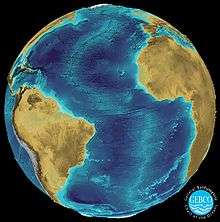General Bathymetric Chart of the Oceans
The General Bathymetric Chart of the Oceans (GEBCO) is a publicly available bathymetric chart of the world's oceans. The project was conceived with the aim of preparing a global series of charts showing the general shape of the seafloor. Over the years it has become a reference map of the bathymetry of the world’s oceans for scientists and others.
Organisation
GEBCO operates under the joint auspices of the International Hydrographic Organization (IHO).[1] and the Intergovernmental Oceanographic Commission (IOC) of UNESCO.[2] Its work is done by an international group of experts in seafloor mapping who develop a range of bathymetric data sets and data products.
Data sets and products


Although originally GEBCO published paper contour charts, today it has moved into the digital age and collects digital depths of the ocean from wherever they are available. GEBCO provides a range of bathymetric data sets and data products, including:
- Global gridded bathymetric data sets:
- GEBCO_08 Grid — a global bathymetric grid with 30 arc-second spacing, generated by combining quality-controlled ship depth soundings with interpolation between sounding points guided by satellite-derived gravity data.
- GEBCO_2014 Grid — an update to the previously released GEBCO_08 Grid.[3]
- GEBCO_2019 Grid — an update to the previously released GEBCO_2014 Grid with 15 arc-second resolution.
- GEBCO One Minute Grid — a global grid at one arc-minute intervals, based largely on the most recent set of bathymetric contours contained within the GEBCO Digital Atlas.
The grids are available to download from the British Oceanographic Data Centre (BODC) in the form of netCDF files, along with free software for displaying and accessing data in ASCII and netCDF. The grids can be used with the Generic Mapping Tools (GMT) system.
- The GEBCO Digital Atlas — a two volume CDROM set which contains:
- The GEBCO One Minute Grid
- A global set of digital bathymetric contours and coastlines
- The GEBCO Gazetteer of Undersea Feature Names: a digital gazetteer of undersea feature names.
- A software interface for viewing and accessing the data sets
- The GEBCO Gazetteer of Undersea Feature Names — a digital gazetteer of undersea feature names used on sheets and products of GEBCO and Regional International Bathymetric Charts (IBC) projects, and on international (INT) nautical charts. It is available to be downloaded from the International Hydrographic Organization (IHO).
- The GEBCO world map — a global, coloured, paper map of the bathymetry of the world's oceans based upon the GEBCO One Minute Grid. The map is available to be downloaded in the form of JPEG file.
Project history
The GEBCO chart series was initiated in 1903 by an international group of geographers and oceanographers, under the leadership of Prince Albert I of Monaco. At that time there was an explosion of interest in the study of the natural world and this group recognized the importance of a set of maps describing the shape of the ocean floor. The first hundred years of the project were described in the book The History of GEBCO 1903-2003 published by GITC in 2003.[4] Nowadays GEBCO’s role has become increasingly important, due to the increased interest in the oceans for scientific research and for the exploitation and conservation of resources.
Since 1903, five separate editions of paper, bathymetric contour charts covering the whole world have been produced. GEBCO is now maintained in digital form as the GEBCO Digital Atlas.
Training
The Nippon Foundation of Japan has provided funding for GEBCO to train a new generation of scientists and hydrographers in ocean bathymetry. The 12-month course, leading to a Postgraduate Certificate in Ocean Bathymetry (PCOB), has been held at the University of New Hampshire, USA, since 2004. 60 GEBCO scholars from 31 different countries have completed the course and are supporting GEBCO programs.
References
- IHO Committees & Working Groups listing for the GEBCO Guiding Committee Archived 2009-05-25 at the Wayback Machine
- IOC/EC-XLI/2 Annex 8, Terms of Reference and Rules of Procedure of the Technical Sub-committee on Ocean Mapping (TSCOM), Sub-committee on Undersea Features Names (SCUFN) and Joint IHO–IOC GEBCO Guiding Committee, Authored by the IOC Secretariat, Published on 26/05/08
- Update history of the GEBCO 30 arc-second grid
- The History of GEBCO 1903-2003 published by GITC in 2003
External links
- Official website
- GEBCO Digital Atlas
- GEBCO's gridded data sets
- GEBCO world map
- Derived products from the GEBCO 2019 Grid like contours and a classification
- The Academy Of Positioning Marine And Bathymetry (APOMAB) — is an independent, no-profit, no-governmental. It provides a forum for all those involved in activities related to the disciplines of marine positioning and bathymetry members who live or work anywhere in the world.